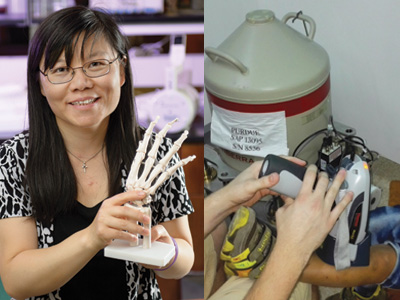
Linda Nie, Associate Professor Health Sciences (Photo John Underwood). Vivo Neutron Activation Analysis (VNAA) device (Photo provided).
Although exposure to lead and other poisonous heavy metals like manganese has been reduced in the U.S. since the passage of the Clean Air and Clean Water acts in the 1970s, the Centers for Disease Control and Prevention estimates that children in at least 14 million households are being exposed to high levels of lead. Lead and similar chemical elements also remain a significant environmental toxin globally, particularly in China and other countries where industrialization is occurring.
Linda Nie, associate professor of health sciences, says the effects of lead poisoning in children are particularly well-documented, ranging from lower intellectual quotient and deficits in neurobehavioral performance to decreases in auditory sensitivity, visual motor performance and learning ability.
Despite increased awareness, testing and controls, there are many unanswered questions regarding excessive exposure to heavy metals, Nie says. Progress also has been slowed by limitations in traditional testing methods.
Blood lead, for example, the most commonly used biomarker for assessment, has a half-life of just 30 days and reflects only short-term exposure, Nie says. In contrast, bone lead has a half-life of several years to decades, making it a better marker of cumulative or long-term exposure.
"X-ray fluorescence (XRF) is less invasive than blood testing and has been used to measure lead in bone for more than 20 years, but few research institutions possess the technology because of infrastructure demands for the detection system and the need for a specialist to operate it," Nie says. "A more accessible technology to measure bone lead would have numerous benefits."
To address the issue, Nie and her team developed portable X-ray fluorescent technology to measure lead in vivo, or within the body, with minimum radiation harm. Funded by a reciprocal travel grant from the Chinese Visiting Scholars Network, Nie first put her innovation to the test on a 2014 visit to Shanghai Jiaotong University's Xinhua Hospital in China, accompanied by PhD student Aaron Specht and faculty colleagues Wei Zheng and Ellen Wells.
In addition to validating the portable bone lead measurement system developed in Nie's lab at Purdue, the research team gathered data from more than 200 field measurements of lead levels in children's tibias to show that cumulative exposure to the toxic metal is highly correlated with bone lead concentration and to test the efficacy of the treatment of lead poisoning for these children. Specht returned to Shanghai in August 2015 to finalize the study before presenting the group's findings to the International Society of Exposure Sciences.
Meanwhile, Nie and her team, together with her collaborators Zheng and Wells, prepared to field test another new technology called in vivo neutron activation analysis (IVNAA) that for the first time measures manganese in bone. Like lead, manganese has serious neurological effects but is difficult and expensive to test, Nie says.
"Chronic manganese exposure is prevalent in Chinese industry, which is rapidly growing," Nie says. "People who work in mining, welding and steel production are especially at risk."











